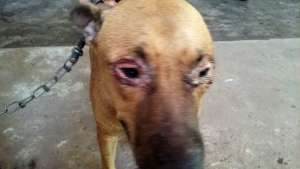Super User
Leishmaniose
Anaplasma, Ehrlichia and Rickettsia Species Infections in cats
Resumo:
Overview: Anaplasma species, Ehrlichia species and Rickettsia species are vector-borne pathogens infecting a wide variety of mammals, but causing disease in very few of them.
Infection in cats: Anaplasma phagocytophilum is the most important feline pathogen among these rickettsial organisms, and coinfections are possible. Little information is available on the pathogenesis of these agents in cats. Clinical signs are usually
reported soon after tick infestation. They are mostly non-specific, consisting of fever, anorexia and lethargy. Joint pain may occur.
Infection in humans: Some rickettsial species (A phagocytophilum, Ehrlichia chaffeensis, Ehrlichia ewingii, Rickettsia conorii, Rickettsia rickettsii, Rickettsia felis, Rickettsia typhi and Candidatus Neoehrlichia mikurensis) are of zoonotic concern. Direct contact with cat saliva should be avoided because of potential contamination by R felis. Infected cats are ‘sentinels’ of the presence of rickettsial pathogens in ticks and fleas in a given geographical area, and they signal a risk for people
exposed to vectors.
Link para o artigo: clique aqui.
Optimization of a molecular method for the diagnosis of canine babesiosis
Resumo:
Babesiosis is a hemolytic disease caused by protozoans of the genus Babesia (Apicomplexa). Tis disease occurs worldwide and is transmitted by ticks to a variety of mammals, including humans. Te objective of the present study
was to optimize a molecular approach for the detection of a fragment of 18S rDNA of Babesia canis, Babesia vogeli, Babesia rossi or Babesia gibsoni based on a single semi-nested Polymerase Chain Reaction (PCR), and compare the
efciency of this approach with that of a simple PCR protocol. To this end, 100 blood samples collected from dogs with suspected hemoparasite infections were analyzed. A comparison of the results of simple PCR and semi-nested
PCR indicated a highly signifcant difference (p value = 0.0000). While only fve (5%) of the samples tested positive using the simple protocol, 22 (22%) were positive using the snPCR technique. Te results of this study reinforce the
fndings of previous studies, which have demonstrated the greater sensitivity of tests based on nested or semi-nested PCR. Terefore, to avoid false-negative results due to low levels of parasitemia, we suggest the preferential use of
this protocol in epidemiological studies of canine babesiosis, particularly those that require reliable estimates of the prevalence of infection.
Link para o artigo: clique aqui.
Detection of Ehrlichia canis and Anaplasma platys DNA using multiplex PCR
Resumo:
We hereby propose a novel sensitive, specific, and cost-efficient method to detect Ehrlichia canis and Anaplasma platys DNA from canine whole blood samples by multiplex PCR. Blood samples from hemoparasited dogs attending the Veterinary Hospital at the Universidade Federal Rural da Amazônia-UFRA, Belém, Brazil, were collected in tubes containing EDTA. Amplification of E. canis and A. platys 16S rDNA by nested (n) PCR was successfully achieved by using primers specific to the Anaplasmataceae in the first round of PCR, followed by a second round of PCR using E. canis-specific primers in conjunction with A. platys-specific primers. The amplicons obtained were cloned and sequenced, yielding sequences of 478 and 473 bp (including primers) pertaining to regions of the 16S rDNA of E. canis and A. platys, respectively. The protocol we here propose may help to measure the prevalence of canine monocytic ehrlichiosis (CME) and canine cyclic thrompocytopenia, not only in northern Brazil, where there is no data available, but also elsewhere.
Link para o artigo: clique aqui.
Molecular analysis reveals the diversity of Hepatozoon species naturally infecting domestic dogs in a northern region of Brazil
Resumo:
This study aimed to optimize molecular methods for detecting DNA of Hepatozoon spp. as well as identify the phylogenetic relationships of Hepatozoon strains naturally infecting domestic dogs in Belém, Pará, northern Brazil. Blood samples were collected from 138 dogs, and screened for Hepatozoon spp. using a new nested PCR assay. Positive samples were subjected to genetic characterization based on amplification and sequencing of approximately 670bp of the Hepatozoon spp. 18S rRNA. Of the positive dogs, four shared the haplotype Belém 01, one dog presented the haplotype Belém 02 and two dogs shared the haplotype Belém 03. A Bayesian inference indicates that haplotypes Belém 01 and Belém 02 are phylogenetically related to H. canis, while Belém 03 is related to H. americanum. Overall, based on the first molecular evidence of H. americanum in Brazilian domestic dogs, the proposed protocol may improve the epidemiological investigation of canine hepatozoonosis.
Link para o artigo: clique aqui.
Investigação molecular de Ehrlichia spp. e Anaplasma platys em felinos domésticos: alterações clínicas, hematológicas e bioquímicas
Resumo:
Ehrlichia sp. e Anaplasma platys são micro-organismos Gram negativos, parasitos intracelulares obrigatórios, residindo em vacúolos citoplasmáticos de leucócitos e plaquetas, encontrados no sangue periférico ou em tecidos. Poucos relatos têm sido feitos sobre erliquiose e anaplasmose em gatos no Brasil, os quais são baseados na presença de mórulas em leucócitos e plaquetas, ou pela detecção de anticorpos. O objetivo deste trabalho foi investigar a infecção natural por Ehrlichia sp. e A.platys em gatos no Município de Campos dos Goytacazes-RJ, através da hematoscopia e pela detecção do DNA desses agentes. Foram utilizadas amostras de sangue total e de soro de 91 gatos, independente de raça, sexo e idade. Realizaram-se hemograma, bioquímica sérica e PCR, utilizando oligonucleotídes para Ehrlichia sp. e A.platys. Os dados de hematoscopia mostraram que 9,89% dos gatos apresentaram mórulas em macroplaquetas. O DNA de A.platys foi detectado em 13,18% dos 91 animais e em 44,44% das amostras positivas à hematoscopia. O DNA de Ehrlichia sp. não foi detectado em nenhuma amostra. Nenhuma alteração foi observada nos sinais clínicos nem nos resultados laboratoriais nos animais estudados. Os dados sugerem que os felinos domésticos podem atuar como potenciais reservatórios para A. platys, como forma não sintomática das enfermidades relacionadas.
Link para o artigo: clique aqui.



